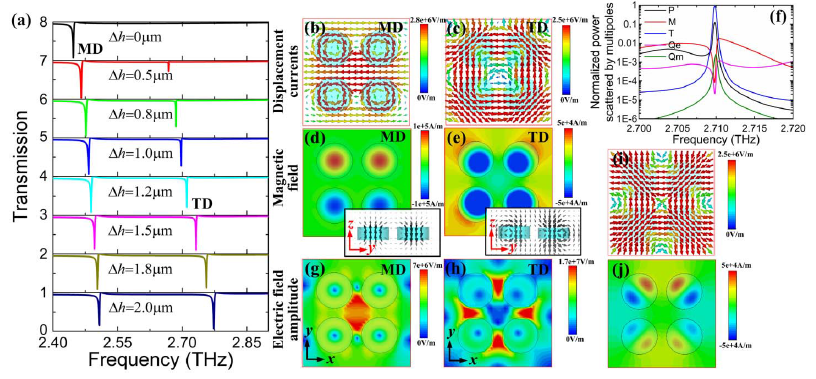As one of the fundamental electromagnetic excitations, toroidal dipoles (TDs), which are different from the traditional electric and magnetic dipoles, have crucial influences on optical response of materials such as absorption and dispersion. The TD resonance can reduce the radiation loss of material and form an Ultrahigh-Q optical resonator greatly enhancing the light-matter interaction, which can be used as sensitive sensors.
Recently researches based on metallic metamaterials (MMs) with TD resonance have been presented at terahertz and visible spectral ranges. However, the metallic toroidal MMs is unavoidable to suffer serious obstacles like complicated shape, material loss and joule heating. Are there any delicate design methods to overcome the intrinsic defects of metallic MMs?
A research led by Prof. Dr. FAN wenhui from Xi'an Institute of Optics and Precision Mechanics (XIOPM) of the Chinese Academy of Sciences (CAS) firstly proposed a TD response based on height asymmetrical all-dielectric MMs. Using this novel structure, the strong TD response with Ultrahigh-Q is excited for terahertz sensing. The results were published in Optics Letters.
 Schematic of the proposed structure and calculated results. (Image by XIOPM)
Schematic of the proposed structure and calculated results. (Image by XIOPM)
In their design, the structure consists of square clusters containing four dielectric disks deposited on quartz substrate, where the microfluidic channel is sealed by a quartz cap. Two pairs of disks with different height making the unit cell asymmetrical to the x-axis for TD resonance generation. LiTaO3 is chosen as the dielectric disk due to its high permittivity.
The strong TD response with Ultrahigh-Q related to the existence of the trapped mode and coupling with incident wave is numerically investigated. The results show the Q-factor and the corresponding FoM could respectively reach 3189 and 515. By integrating the microfluidic channel, the proposed sensor could be very useful for sensing various materials such as gases and liquids.
The advantages of designed structure present potential applications for label-free and high performance biological and chemical sensors.
Download: